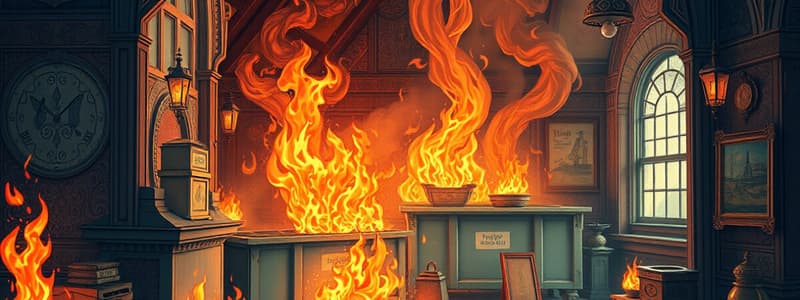Podcast
Questions and Answers
What is the pressure setting used in the 'Constant Pressure Method' for relay pumping?
What is the pressure setting used in the 'Constant Pressure Method' for relay pumping?
- 180 psi
- 150 psi (correct)
- 200 psi
- 120 psi
What is the recommended minimum amount of water to ensure for tanker swap out and refill in operations involving tankers with pumps?
What is the recommended minimum amount of water to ensure for tanker swap out and refill in operations involving tankers with pumps?
- 1000 gallons (correct)
- 1500 gallons
- 750 gallons
- 2000 gallons
What type of threads do TFD's 3" lines use?
What type of threads do TFD's 3" lines use?
- Fire Hose Threads
- Metric Threads
- National Standard Threads (correct)
- American National Threads
In what situation would TFD engines draft water?
In what situation would TFD engines draft water?
What method is used when tankers without pumps deliver water to TFD?
What method is used when tankers without pumps deliver water to TFD?
What is the compatibility of TFD’s 3" lines with mutual aid lines?
What is the compatibility of TFD’s 3" lines with mutual aid lines?
Which of the following is NOT a method TFD utilizes to receive water from tenders without pumps?
Which of the following is NOT a method TFD utilizes to receive water from tenders without pumps?
What is the role of the second engine in operations involving tankers with pumps?
What is the role of the second engine in operations involving tankers with pumps?
What is the recommended firefighting approach for tightly-packed materials in dumpsters?
What is the recommended firefighting approach for tightly-packed materials in dumpsters?
Which of the following statements regarding dumpster fires is correct?
Which of the following statements regarding dumpster fires is correct?
In compactor fires, what must be done if the fire has entered the compactor itself?
In compactor fires, what must be done if the fire has entered the compactor itself?
What potential hazard does a compactor arrangement with trash chutes in the building present?
What potential hazard does a compactor arrangement with trash chutes in the building present?
What is a common issue that can cause fires in compactors with trash chutes?
What is a common issue that can cause fires in compactors with trash chutes?
Which type of line is generally sufficient for most dumpsters?
Which type of line is generally sufficient for most dumpsters?
What should be done if a dumpster needs to be moved away from structures or vehicles?
What should be done if a dumpster needs to be moved away from structures or vehicles?
Larger dumpsters, such as _____ dumpsters may need a larger line
Larger dumpsters, such as _____ dumpsters may need a larger line
Most compactors are _____ fed and are a stand alone unit that either bails or compacts into a large detachable container
Most compactors are _____ fed and are a stand alone unit that either bails or compacts into a large detachable container
Compactors of this type are generally found in _____ service area or on the outside of a building
Compactors of this type are generally found in _____ service area or on the outside of a building
Many mutual aid departments engines have ____ gal(or greater) water tanks and are preferred for use as the second engine if available
Many mutual aid departments engines have ____ gal(or greater) water tanks and are preferred for use as the second engine if available
Flashcards
Class A foam for dumpster fires
Class A foam for dumpster fires
A type of fire extinguisher recommended for tightly packed materials like those found in dumpsters.
Appropriate hose size for dumpster fires
Appropriate hose size for dumpster fires
Booster lines are sufficient for standard dumpsters, while larger lines might be needed for construction dumpsters.
Safety precaution for dumpster fires
Safety precaution for dumpster fires
Once a dumpster fire is controlled, avoid approaching it further to prevent exposure to toxic fumes.
Dumpster access for fire fighting
Dumpster access for fire fighting
Signup and view all the flashcards
Dumpster Relocation for Fire Safety
Dumpster Relocation for Fire Safety
Signup and view all the flashcards
Compactor Definition
Compactor Definition
Signup and view all the flashcards
Compactor Fire Complexity
Compactor Fire Complexity
Signup and view all the flashcards
Compactor Fire Safety: Energy Source
Compactor Fire Safety: Energy Source
Signup and view all the flashcards
Compactor Trash Chute Hazards
Compactor Trash Chute Hazards
Signup and view all the flashcards
Compactor Fire Safety Features
Compactor Fire Safety Features
Signup and view all the flashcards
Constant Pressure Method for Relay Pumping
Constant Pressure Method for Relay Pumping
Signup and view all the flashcards
Relay Pumping Definition
Relay Pumping Definition
Signup and view all the flashcards
Tanker with Pump Operation
Tanker with Pump Operation
Signup and view all the flashcards
Tanker with Pump: Two Engine Setup
Tanker with Pump: Two Engine Setup
Signup and view all the flashcards
Tanker without Pump Operation
Tanker without Pump Operation
Signup and view all the flashcards
TFD Engine Reliance on Mutual Aid
TFD Engine Reliance on Mutual Aid
Signup and view all the flashcards
Study Notes
Dumpster/Compactor Fires
- Class A foam is recommended for extinguishing tightly-packed materials in dumpsters.
- Use appropriate size lines; booster lines are usually sufficient for standard dumpsters, while larger lines may be necessary for construction dumpsters.
- Avoid leaning over the edge of dumpsters; once a dumpster fire is controlled, it should not be approached further to prevent exposure to toxic fumes.
- Many larger dumpsters have side doors that can be utilized for better access to extinguish fires.
- Consider relocating dumpsters away from structures and vehicles, potentially requiring vehicle assistance to pull larger dumpsters.
Compactors
- Most compactors are standalone units that either compact or balk material into a detachable container, often located in fire-rated service areas.
- Compactor fires can be labor-intensive, with detached containers resembling a large dumpster.
- If a fire spreads into the compactor mechanism, it is crucial to lock out the energy source before addressing combustibles.
- Some rarer compactors come with trash chutes, which pose significant hazards to buildings and occupants; internal exposures must be assessed, particularly if fires are linked to blocked chutes.
- Modern compactors typically include fire detection and suppression systems.
Response to Areas Without Hydrants
- When relay pumping is necessary, employ the "Constant Pressure Method" (150 psi and 1000 ft of 5" hose per engine) as per the IFSTA Pumping Apparatus Driver/Operator handbook.
Water Tender Operations
- Water tender operations can involve tankers with or without pumps.
Tankers with Pumps
- Tankers equipped with pumps can supply water using a 3" line, compatible with TFD's 2½" National Standard Threads.
- It is advised to use two engines: one to pump fire streams and the second to receive water from the tanker. This ensures at least 1000 gallons are available for sustained operations.
- The forward engine pumps streams while the second engine maintains a full tank for reserve capacity during tanker swaps.
Tenders Without Pumps
- Tenders that lack pumps must unload their water into portable tanks; an engine must then draft from these tanks.
- TFD engines do not carry hard suction hoses and will rely on either a mutual aid engine drafting from a portable tank or allowing a mutual aid engine to directly supply water from their portable tank.
Studying That Suits You
Use AI to generate personalized quizzes and flashcards to suit your learning preferences.
Description
Explore essential safety measures and techniques for responding to dumpster and compactor fires. This quiz covers the recommended equipment, access strategies, and precautions to minimize risks during fire incidents. Perfect for emergency responders and fire safety professionals.




